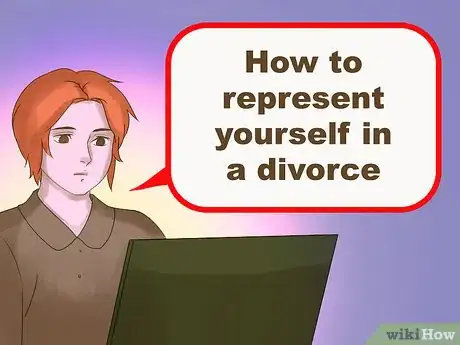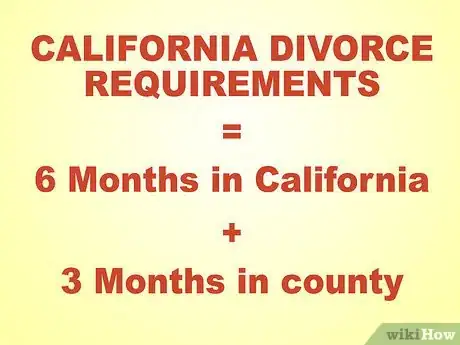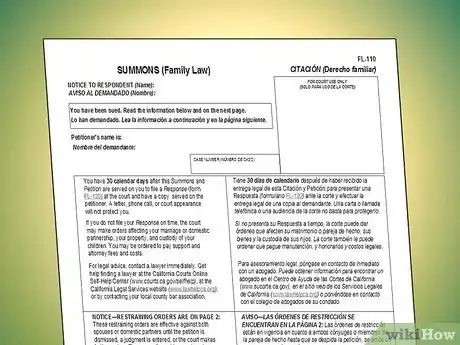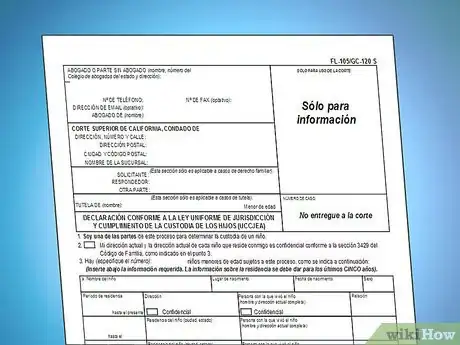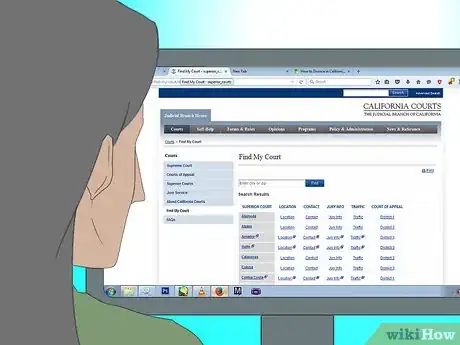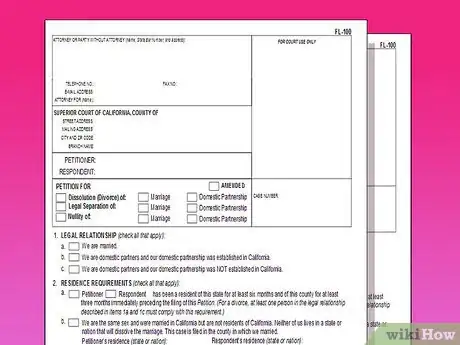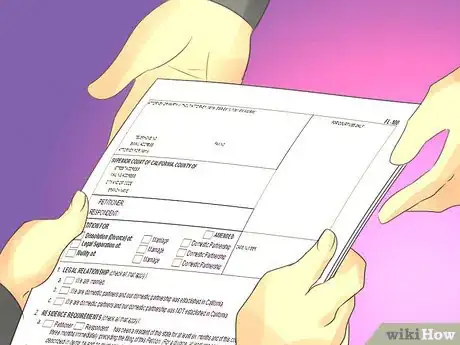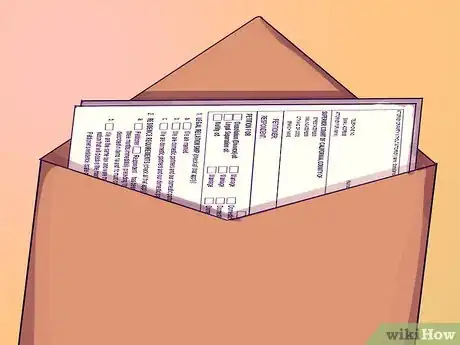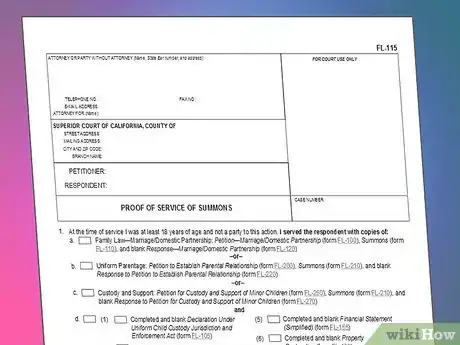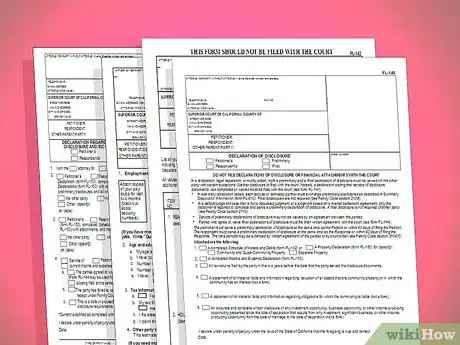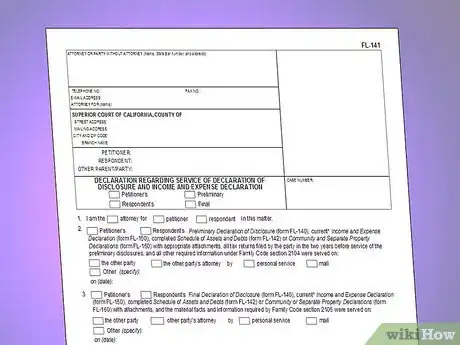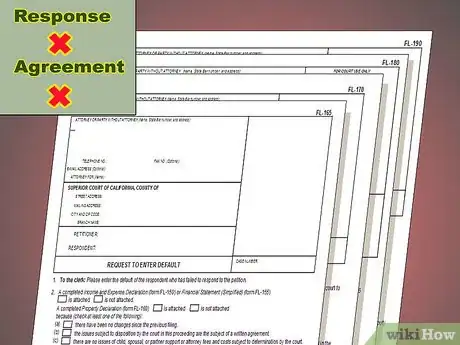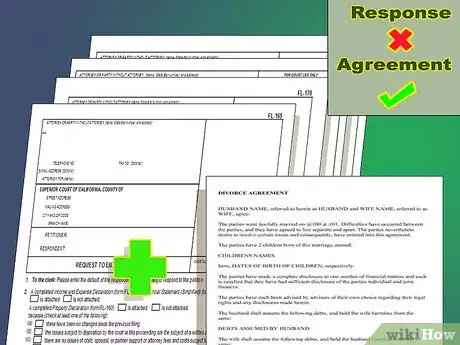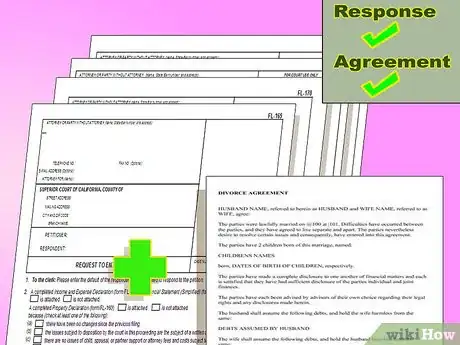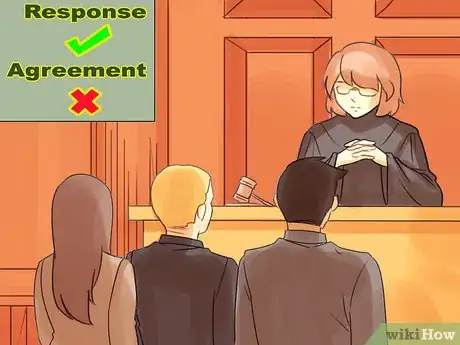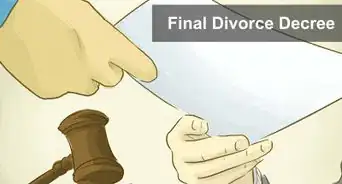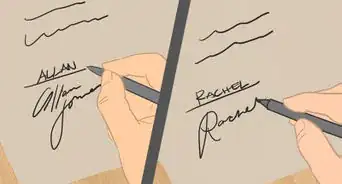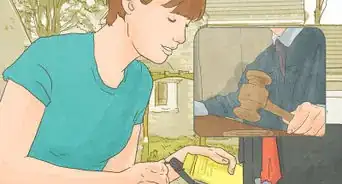This article was co-authored by Clinton M. Sandvick, JD, PhD. Clinton M. Sandvick worked as a civil litigator in California for over 7 years. He received his JD from the University of Wisconsin-Madison in 1998 and his PhD in American History from the University of Oregon in 2013.
There are 10 references cited in this article, which can be found at the bottom of the page.
wikiHow marks an article as reader-approved once it receives enough positive feedback. In this case, 92% of readers who voted found the article helpful, earning it our reader-approved status.
This article has been viewed 310,909 times.
If you are a California resident who is contemplating ending his or her marriage through divorce or your spouse has served you with divorce papers, it is very important that you educate yourself about the divorce process. You and your spouse may be able to negotiate the terms of your divorce together, use a mediator or both hire attorneys to decide issues of spousal support, child support, child custody, and the division of marital assets.
Steps
Understanding Divorce Methods in California
-
1Represent yourself in the divorce. Many people choose to negotiate the terms of their divorce without hiring an attorney. They may choose to rely on local court resources, self-help books or internet services to help negotiate the divorce. Choosing to represent yourself may be a good option for you if:
- You feel comfortable filing court documents and negotiating with your spouse.
- The divorce was a mutual decision and both parties are amicable and willing to work together.
- There is little to no property to be divided.
- Your spouse is not hiring an attorney.
- There are no children.[1]
-
2Hire a mediator. A mediator is a neutral third-party that you and your spouse hire to help you negotiate the terms of your divorce. The goal of mediation is to agree to a legally binding “Judgment of Dissolution,” which sets forth the parameters of your divorce. A mediator does not provide legal advice but rather helps you and your spouse understand alternatives and come up with solutions to reach a settlement. A mediator may be a good choice for you if:
- You and your spouse openly and voluntarily share financial information.
- Both parties prefer to handle the specifics of their divorce in private rather than in court.
- You want someone to help facilitate a conversation and plan for parenting and custody.
- You wish to spend less money on the divorce.
- Even if you choose to use a mediator, you should consider hiring an attorney to review the settlement before it is finalized.[2]
Advertisement -
3Engage in a collaborative divorce. A collaborative divorce is when both spouses retain attorneys with the purpose of reaching an out-of-court settlement. Collaborative attorneys do not represent individuals in court but rather facilitate exchange of documents, negotiating custody issues and property distribution in an amicable and cooperative manner.[3] A collaborative divorce may be a good choice for you if:
- Both parties want the divorce and it is not contentious.
- Both parties agree to a collaborative process.
- Both attorneys agree not to become involved in litigation over the divorce.
- Both parties agree to turn over all relevant documents and information.
- Both parties agree to act in the best interest of their children, if any, and to not use those children in the divorce proceedings.[4]
-
4Hire an attorney. It may be in your best interest to hire an attorney to handle your divorce. Experienced family law attorneys will know how to negotiate a divorce settlement, understand and complete all of the specific paperwork, serve and file court documents, and make appearances in court, if necessary. Choosing to hire an attorney may be the right decision for you if:
- You are concerned that your spouse is hiding assets or not turning over complete financial information.
- The divorce is contentious.
- There is a fight over child custody.
- You are uncomfortable filling out and filing court documents.
- Your spouse has an attorney.[5]
-
5Locate an attorney. You can locate attorneys in a number of ways, including:
- Referral from friend or family member. If someone you know used an attorney for their divorce, you can ask them whether they would recommend that attorney. A recommendation from a trusted person who has personal experience with an attorney is a good place to start.
- Local or state legal bar associations. Local and state bar associations often provide referral services to attorneys in your area. Through state bar associations, you can check whether any complaints were filed against your prospective attorney. The American Bar Association has compiled a list of state-by-state resources that can direct you to attorney referral sites, such as contact information for state bar associations. The ABA provides this information at https://www.americanbar.org/groups/legal_services/flh-home/
- State Bar-certified lawyer referral service in your area. You can find a list of certified lawyer referral services on the California Bar’s website at: http://www.calbar.ca.gov/Public/LawyerReferralServicesLRS.aspx. You can also contact the California Bar at 1-866-44-CA-LAW (442-2529) or from out of state at 415-538-2250.
-
6Understand property division in California. California is a community property state, which means that property accumulated during the marriage is considered marital property and the overall value of shared property is divided evenly. If you owned property before the marriage, that property is considered separate property and it is not subject to division.[6]
- California courts allow couples to decide how the property will be divided; however, a judge must sign off on the agreement and issue a final order.[7]
Drafting and Serving Your Divorce Petition in California
-
1Determine in which county to file for divorce. In order to file for divorce in California, you must meet certain residency requirements. Specifically, you or your spouse must have lived in California for at least 6 months and lived in your current county for 3 months. You can file your divorce in the following places:
- If both spouses resided in California for 6 months and the same county for the previous 3 months, you would file your divorce in the county where you reside.
- If both spouses resided in California for 6 months and in different counties for the previous 3 months, you could file your divorce in either county where a spouse resides.
- If one spouse resided in California for 6 months and the same county for the previous 3 months, and the other spouse did not reside in California or in the same California county for 3 months, you would file the divorce in the county of the spouse who resided there for 3 months.
- If neither spouse resided in California for 6 months or in a county for the previous 3 months, you cannot file your divorce in California.[8]
-
2Fill out a Petition to start divorce proceedings. Once you have determine where you can file for divorce, you can begin preparing the required paperwork. The first document you must complete is a “Petition — Marriage/Domestic Partnership,” Form Fl-100, which can be found at: http://www.courts.ca.gov/documents/fl100.pdf. To complete the form you must:
- Write in blue or black ink or type the information.
- Provide your name, address, phone number and email address.
- Provide your name as the Petitioner (person filing for divorce) and your spouse’s name as Respondent.
- Set forth that you are dissolving a marriage, whether you have children, and if so, provide their names, birth dates and ages.
- Identify property that you had before the marriage.
- Indicate whether you have marital assets or debt.
- Indicate whether you have attorney’s fees.
- Date, print and sign your name.[9]
-
3Fill out and read the Summons form. The summons requests that you provide the names of you and your spouse. You can download the Summons, Form FL-110 at http://www.courts.ca.gov/documents/fl110.pdf. This form also provides important information related to the divorce process, including:
- The time frame that the responding spouse has to respond.
- Restraining orders against both parties restraining them from removing minor children from the jurisdiction.
- Restraining orders against both parties restraining them from changing the beneficiaries of health insurance, life insurance or other insurance programs.
- Restraining orders against both parties restraining them from hiding or disposing of property.[10]
-
4Complete a Declaration Under Uniform Child Custody Jurisdiction and Enforcement Act Form. If you have children under the age of 18 with your spouse you must fill out and file this form, located at https://www.courts.ca.gov/documents/fl105.pdf. This form requests information regarding your children and any custody agreements that are already in place.
-
5Check to see whether your local court requires specific forms. Some county courts require that you complete additional forms for their county. You can determine whether there are any additional forms by calling the court clerk or searching on the court’s website, which can be found here: http://www.courts.ca.gov/find-my-court.htm.
- Complete additional forms. If the court where you are filing for divorce requires any additional forms, be sure to download and complete the forms in accordance with the instructions.[11]
-
6Make at least two copies of all of your forms. When you file your forms in the court, the court will keep the original and you will have one copy for yourself and one copy to serve on your spouse.
-
7File your forms with the court clerk for your county. When filing for divorce, take the originals and copies of your Petition, Summons and Declaration (if applicable) to the court clerk. If the documents appear to be in order, the clerk will stamp and keep the original. The court will also stamp your copies as “filed” and return them to you.
- You will have to pay a filing fee for your documents. You can determine the amount of the fee here: http://www.courts.ca.gov/documents/filingfees.pdf.
- If you cannot afford to pay a filing fee, you may request a fee waiver by filling out a fee waiver form located at: http://www.courts.ca.gov/selfhelp-feewaiver.htm.[12]
-
8Gather divorce papers to serve on your spouse. Once you have filed your divorce papers with the court, you are legally required to serve (officially give a copy) to your spouse. You must serve your spouse with the following documents:
- A copy of the Petition — Marriage/Domestic Partnership that you filed with the court.
- A copy of the Summons that you filed with the court.
- A copy of the Declaration Under Uniform Child Custody Jurisdiction and Enforcement Act Form that you filed with the court (if applicable).
- A copy of any local county forms.
- A blank Response — Marriage/Domestic Partnership form, located at http://www.courts.ca.gov/documents/fl120.pdf.
- If you have children and filed your own Declaration, you must also serve your spouse with a blank Declaration Under Uniform Child Custody Jurisdiction and Enforcement Act (UCCJEA) form, located at https://www.courts.ca.gov/documents/fl105.pdf.[13]
-
9Serve your spouse with the divorce papers. Once you have gathered all of the applicable documents, you are legally required to provide a copy of the papers to your spouse. This is called “service” and you can serve your spouse in the following ways:
- A person over the age of 18, that is not you, can hand deliver a copy of the divorce papers to your spouse. This person can be a friend, relative, professional process server or a county sheriff. This is referred to as personal service.
- You can also serve your spouse by mail, which means that you send your spouse a copy of the divorce papers by registered mail and with a Notice and Acknowledgement of receipt form. You can find a copy of this form here: http://www.courts.ca.gov/documents/fl117.pdf.[14]
-
10Fill out and file Proof of Service of Summons. If you used personal service, the person who served your spouse must complete a Proof of Service of Summons form located at http://www.courts.ca.gov/documents/fl115.pdf. This form demonstrates that your spouse was given the documents.[15] If you received a Proof of Service of Summons or a Notice and Acknowledgement of Receipt, you must file these documents with the court to demonstrate that you complied with the legal requirements of service.
-
11Wait for a Response. The spouse who was served divorce papers (Respondent) has 30 days to complete the Response — Marriage/Domestic Partnership form and serve you with the document.[16]
Gathering and Disclosing Financial Information
-
1Gather financial information. Once you filed your Petition, you have 60 days to file your financial disclosures. You should immediately begin collecting your financial documents, which may include:
- W-2 and 1099s for the previous year.
- Paystubs for at least two pay periods.
- Copy of all deeds, car titles and car registrations.
- List of all retirement accounts, credit cards, bank accounts
- List of all debt, including loans, mortgages, and/or credit cards.[17]
-
2Complete Financial Disclosure forms. You must complete and file these documents with the court within 60 days of filing your petition. The forms include:
- Declaration of Disclosure (Form FL-140). This is a cover sheet for your declaration of disclosure and you must check all of the applicable boxes on the front page and attest to the truth of your statements. The form can be found at: http://www.courts.ca.gov/documents/fl140.pdf
- Schedule of Assets and Debts (Form FL-142). This document lists all of the assets and debts of you and your spouse. If the asset was acquired before the marriage you can note that on the form as separate property. You can find the form at: http://www.courts.ca.gov/documents/fl142.pdf
- Income and Expense Declaration (Form FL-150). This documents sets forth all of your earnings and expenses. You will be required to attach W-2s and/or 1099 forms. If you are a business owner, you may need to submit profit and loss statements for the company. Form FL-150 can be found at: http://www.courts.ca.gov/documents/fl150.pdf
- Declaration Regarding Service of Declaration of Disclosure (Form FL-141). This document requires you to mark that you are serving the document and on whom the document was served. You can locate the form at: http://www.courts.ca.gov/documents/fl141.pdf[18]
-
3File your financial disclosures with the court. Take the original and two copies of your financial disclosures to the court. The court will stamp and keep the original and stamp and return your copies.[19]
-
4Serve the financial disclosures and file a declaration regarding service. As discussed above, serve your spouse either by personal service or by registered mail. Once your spouse is served, you must also fill out and file a Declaration Regarding Service of Declaration of Disclosure located at http://www.courts.ca.gov/documents/fl141.pdf. This form demonstrates that you properly provided your spouse with the court documents.[20]
Finalizing the Divorce Case
-
1Complete final divorce forms. The forms you must complete depends on what actions your spouse took in response to your Petition. There are four potential scenarios that could have occurred. These scenarios include:
- Respondent spouse did not file a Response and you did not enter into a written agreement specifying the dissolution of marriage;
- Respondent spouse did not file a Response but you did enter into an agreement;
- Respondent filed a Response and entered into an agreement; or
- Respondent filed a Response and did not enter into an agreement.[21]
-
2Complete forms when there was no Response or agreement. After waiting 30 days after the response was served on the spouse, the Petitioner spouse should complete, file and serve the below documents:
- Complete and File a Request to Enter Default (Form FL-165) located at http://www.courts.ca.gov/documents/fl165.pdf.
- Complete and File a Declaration for Default or Uncontested Dissolution or Legal Separation (Form FL-170) located at http://www.courts.ca.gov/documents/fl170.pdf
- Complete and File a Judgment (Form FL-180), located at http://www.courts.ca.gov/documents/fl180.pdf.
- Complete and File a Notice of Entry of Judgment (Form FL-190), located at http://www.courts.ca.gov/documents/fl190.pdf
- If you are seeking spousal support, child custody, child support, or other orders regarding the divorce you may be required to fill out additional forms that can be located at http://www.courts.ca.gov/8409.htm.
-
3Complete forms when there was an agreement but no Response. In order to finalize your divorce under these circumstances you must:
- Write up your agreement.
- Complete and file the following forms discussed above: Complete and File a Request to Enter Default; Declaration for Default or Uncontested Dissolution or Legal Separation; Judgment; and a Notice of Entry of Judgment.
- Complete a final Declaration of Disclosure, which includes all of the financial disclosure documents you previously filed. These documents include: Declaration of Disclosure; Schedule of Assets and Debts; and Income and Expense Declaration.
-
4Complete forms when there was a Response and an agreement. In this situation, the divorce is considered uncontested. You must complete the following:
- Write up your agreement.
- Complete and file the following forms discussed above: Complete and File a Request to Enter Default; Declaration for Default or Uncontested Dissolution or Legal Separation; Judgment; and a Notice of Entry of Judgment.
- Complete a final Declaration of Disclosure, which includes all of the financial disclosure documents you previously filed. These documents include :Declaration of Disclosure; Schedule of Assets and Debts; and Income and Expense Declaration.[22]
-
5Take the next steps when there was a Response but no agreement. In this situation, your divorce is considered “contested” because the parties cannot agree to a settlement. In order to finalize your divorce you should consider the following:
- Hire a mediator to help facilitate settlement discussions.
- Hire an attorney to litigate your case in court. If you cannot agree on all of your issues, you will have to appear in court for a final determination of your divorce. In this situation, it is best for you retain an attorney who can handle your divorce case.[23]
Warnings
- If you change your mind about the divorce, you can request a case dismissal. However, if you later decide to go through with the divorce you will have to re-file the case, start the entire process over and pay the filing fee again.⧼thumbs_response⧽
References
- ↑ http://www.calbar.ca.gov/Public/Pamphlets/DivorceCustody.aspx#19
- ↑ http://www.calbar.ca.gov/Public/Pamphlets/DivorceCustody.aspx#19
- ↑ http://www.calbar.ca.gov/Public/Pamphlets/DivorceCustody.aspx#19
- ↑ http://www.cadivorce.com/california-divorce-guide/planning-for-a-california-divorce/collaborative-divorce/
- ↑ http://www.calbar.ca.gov/Public/Pamphlets/DivorceCustody.aspx#19
- ↑ http://family.findlaw.com/divorce/divorce-property-division-faq.html
- ↑ http://www.courts.ca.gov/1254.htm
- ↑ http://www.courts.ca.gov/12275.htm
- ↑ http://www.courts.ca.gov/1229.htm
- ↑ http://www.courts.ca.gov/1229.htm
- ↑ http://www.courts.ca.gov/1229.htm
- ↑ http://www.courts.ca.gov/1229.htm
- ↑ http://www.courts.ca.gov/1229.htm
- ↑ http://www.courts.ca.gov/1229.htm
- ↑ http://www.courts.ca.gov/1229.htm
- ↑ http://www.courts.ca.gov/1229.htm
- ↑ https://www.avvo.com/legal-guides/ugc/how-to-complete-financial-disclosure-documents-required-for-divorce-in-california
- ↑ https://www.avvo.com/legal-guides/ugc/how-to-complete-financial-disclosure-documents-required-for-divorce-in-california
- ↑ http://www.courts.ca.gov/1229.htm
- ↑ http://www.courts.ca.gov/1229.htm
- ↑ http://www.courts.ca.gov/1229.htm
- ↑ http://www.courts.ca.gov/8411.htm#un_fillout
- ↑ http://www.courts.ca.gov/1238.htm
- ↑ http://www.courts.ca.gov/selfhelp-selfhelpcenters.htm
About This Article
To divorce in California, complete a Petition – Marriage/Domestic Partnership Form FL100, which you can find on the California state government website, and a Summons Form FL 110. If you have children under the age of 18, you also need to complete a Declaration Under Uniform Child Jurisdiction and Enforcement Act Form. Make 2 copies of all your forms, then file them with your county court clerk. Next, serve your spouse with a copy of all the papers you submitted to the court and a blank copy of the petition for their response. You should also file your financial information within 60 days of serving the papers. For tips on how to finalize the divorce and when to hire an attorney, read on!
